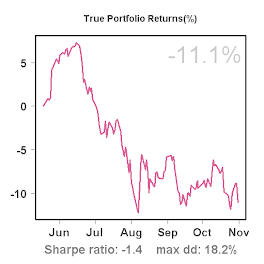What do Weekend Trader's and Trend Plays#1 Sharpe ratios say?
Taking the analysis in my previous post one step further, we can repeat it with the current performance of systems in the portfolio as inputs.
For example, Weekend Trader has a history of 404 trading days, and a Sharpe ratio of 1.68. What I want to know is: What happened to systems with an equal or longer history and a Sharpe ratio of at least 1.68 after they'd been around for 404 trading days?
It turns out 3 systems qualify: Mutual Fund Trader, extreme-os, and ARS.
These are their Sharpe ratios for the period starting after their first 404 trading days:
- Mutual Fund Trader 1.01
- extreme-os 4.01
- ARS 0.87
These odds are not really bad! (But remember that slippage and transaction cost are not accounted for)
We can repeat the same for Trend Plays #1. This system currently has a history of 241 trading days, and a Sharpe ratio of 2.40. Applying the same criteria to all other systems (including those that are terminated, of course), the following qualify: Mutual Fund Trader, extreme-os, vicinoo! trading - Daytrading, and Tango. Each of these had a Sharpe ratio > 2.40 over its first 241 trading days. How did they do afterwards?
- Mutual Fund Trader 1.01
- extreme-os 3.74
- vicinoo! trading - Daytrading 1.92
- Tango 2.14
Not bad either!
There's one big caveat to this kind of analysis: The underlying trend of the market was mostly upwards. If tomorrow a 3-year bear market would start, Sharpe ratios might not look very good for the next 3 years. One way around this would be to look at alphas instead of Sharpe ratios, which could be a good topic for future analysis.


1 comment:
better way, is to look at a system's longs and shorts. In a bull market, the longs should outperform the general market on average, the shorts should be at least SOMEWHAT negative on average...
If the shorts don't have some predictive value, then you probably have a system riding a bull market, with NO value.
(This is Ross, from C2)
Post a Comment